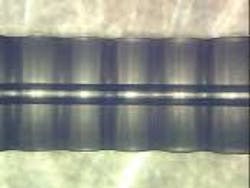Phase-matching generates efficient 13-nm light

A group at the University of Colorado, Boulder (Boulder, CO), led by the husband-and-wife team of Henry Kapteyn and Margaret Murnane, has demonstrated a breakthrough technique to generate efficient coherent extreme-ultraviolet (EUV) light.1 The laser system generates coherent output at 13 nm with sufficient energy to enable applications in EUV lithography, all in a compact tabletop design. The technique, known as quasi-phase-matching, may deliver enough power to make ultrahigh-resolution spectroscopy and high-contrast biological imaging practical in the 300-eV "water window" region of the spectrum at 4.4 nm.
Focusing a femtosecond laser into a gas is a well-known method of producing high-harmonic generation (HHG), which works by transferring the energy from the fundamental frequency of a laser into very high harmonic orders. The conversion efficiency of HHG is limited, however, because ionization of the gas prevents the EUV and laser light from propagating at the same speed. To gain better efficiency and power output from the system, the team incorporated a novel waveguide structure to force the light to match speed and phase.
The structure consists of a 150-µm-diameter hollow fiber modulated via precision glass-blowing techniques with sinusoidal variations in diameter. The modulation periods varied from 1 to 0.5 mm along the length of the fiber, with a radial depth of approximately 10 µm. In the experiment, 25-fs pulses of 760-nm light from a Ti:sapphire laser were focused into a 1-cm-long fiber filled with helium, argon, or neon gas. The periodic structure in the fiber modulates the HHG, restricting it to regions with favorable constructive interference.
For any of the gases, the flux obtained by the phase-matched system was two to five times greater than that obtained by straight fiber. More important, the brightness of the HHG spectrum from the modulated fiber was two orders of magnitude greater than that from straight fibers. For helium gas, the modulated fiber shifted the spectral peak from 68 eV (in straight fiber) to 95 eV. While the output from straight fiber with helium generated energies from 60 to 80 eV, the modulated fiber output spanned a broader energy range from 63 to 112 eV . This broader wavelength output includes the 94-eV (13-nm) wavelength of interest for EUV lithography.
The technique is promising for directly observing nanoscale phenomena, similar to what electron telescopes can observe, without the bulk, expense, and vacuum chambers. "Our goal now is to phase-match at wavelengths below 4.4 nm in the water window for many applications in spectroscopy and microscopy," says Murnane. "Calculations predict that these structures also generate isolated attosecond pulses even when we use relatively long driving laser pulses." Such experimental proof would make waves in the ultrafast laser community—no pun intended.
REFERENCE
- A. Paul et al., Nature 421, 51 (2003).
About the Author
Valerie Coffey-Rosich
Contributing Editor
Valerie Coffey-Rosich is a freelance science and technology writer and editor and a contributing editor for Laser Focus World; she previously served as an Associate Technical Editor (2000-2003) and a Senior Technical Editor (2007-2008) for Laser Focus World.
Valerie holds a BS in physics from the University of Nevada, Reno, and an MA in astronomy from Boston University. She specializes in editing and writing about optics, photonics, astronomy, and physics in academic, reference, and business-to-business publications. In addition to Laser Focus World, her work has appeared online and in print for clients such as the American Institute of Physics, American Heritage Dictionary, BioPhotonics, Encyclopedia Britannica, EuroPhotonics, the Optical Society of America, Photonics Focus, Photonics Spectra, Sky & Telescope, and many others. She is based in Palm Springs, California.
